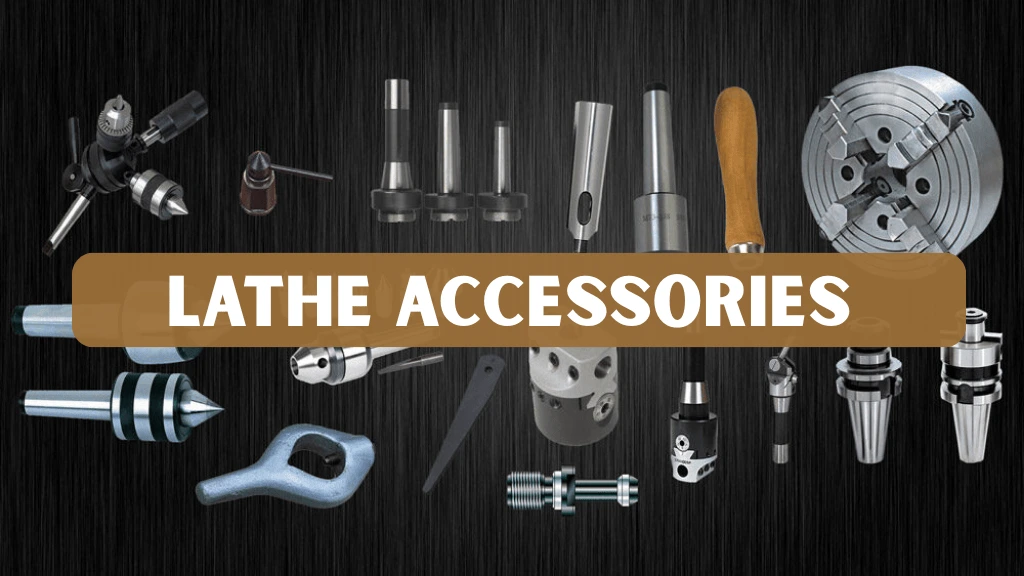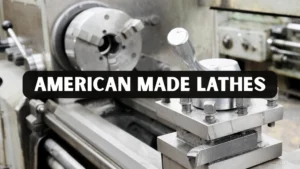Lathes are powerful machines that have shaped industries for centuries. From the earliest wooden treadle lathes to today’s CNC precision tools, the lathe remains central to machining and woodworking. Yet the true versatility of the machine depends on the accessories that accompany it. A basic lathe can turn, face, and bore, but with the right lathe accessories, it becomes a highly adaptable system capable of performing countless specialized tasks.
In this guide, you will discover the most important accessories, their applications, and practical advice for selecting and maintaining them. Whether you are a machinist seeking precision or a woodturner chasing creativity, the right tools will transform how you work.
Why Accessories Make the Lathe Indispensable
While a lathe provides rotational power and stability, accessories are what give it precision, safety, and versatility. A 3-jaw chuck allows fast and accurate mounting of round stock. A steady rest makes it possible to machine slender shafts without deflection. A digital readout converts guesswork into measurable precision. Each of these tools expands the scope of what can be achieved.
Accuracy is one of the greatest benefits. A workpiece that vibrates or slips will never produce a clean finish, but properly selected lathe accessories solve these problems. Functionality is another advantage. By fitting the lathe with the right attachments, machinists can cut threads, bore deep holes, or polish a surface to a mirror finish. Efficiency should not be overlooked either. Accessories like quick change tool posts save hours over the course of a week by reducing setup time. Finally, safety is a constant concern. Strong work-holding devices prevent accidents, protecting both the operator and the project.
A machinist working with a 4-jaw independent chuck can produce precise square fittings. A woodturner mounting an irregular bowl blank to a faceplate can shape curves without worrying about instability. These examples demonstrate how accessories turn potential into performance.
Top Lathe Accessories
Every lathe operator, whether in metalworking or woodworking, relies on essential accessories to get the most from their machine. These tools improve accuracy, increase efficiency, and make it possible to handle a wide variety of projects. Below are the most common accessories and how they are used in real-world settings.
Chucks
Chucks are at the heart of work-holding. The 3-jaw self-centering chuck is quick to use and perfectly suited for round or hexagonal parts. Its jaws move together, automatically aligning the workpiece. The 4-jaw independent chuck offers greater flexibility, as each jaw can be adjusted separately. This makes it possible to grip square or irregular shapes with accuracy.
For smaller precision tasks, collet chucks provide a stronger and more concentric grip, minimizing errors. In lighter operations, especially with delicate components, magnetic chucks can be employed to hold thin workpieces without distortion. A well-equipped shop often keeps several types of chucks on hand because each serves a unique purpose.
Faceplates
Faceplates provide a flat surface for securing large or irregular pieces that cannot be gripped in a chuck. By bolting or screwing the workpiece directly onto the plate, stability is achieved even with asymmetrical blanks. This accessory is especially favored by woodturners who use it when shaping bowls, platters, or sculptural pieces. It provides both strength and versatility when handling awkward forms.
Tool Posts
The tool post is the fixture that holds cutting tools in position. A single tool post is simple and strong, but it requires frequent adjustments when changing tools. By contrast, the quick change tool post allows operators to swap tools instantly. This saves time, particularly in workshops where multiple machining operations must be performed on the same part. Many professionals regard this as one of the most valuable upgrades to a basic lathe.
Centers and Live Centers
Centers support workpieces that are held between the headstock and tailstock. A dead center does not rotate, which makes it better suited to slower speeds or heavy operations. A live center, mounted on bearings, rotates with the workpiece and reduces friction, making it ideal for higher speed turning. Woodturners in particular value live centers when shaping spindles, as they allow smooth, continuous support without damaging the workpiece.
Steady and Follower Rests
Long workpieces often suffer from vibration and bending during machining. A steady rest is clamped to the lathe bed and provides firm support at a fixed point, preventing deflection. A follower rest travels along with the cutting tool, maintaining contact and stability throughout the process. Both are indispensable when producing slender shafts or rods, where accuracy and surface quality must be maintained from end to end.
Lathe Dogs and Drive Plates
Lathe dogs, combined with drive plates, are used in between-centers machining. The dog attaches to the workpiece and engages with the drive plate, transferring motion from the spindle. This traditional method is valued for its accuracy and is still used when producing highly precise cylindrical parts. Although slower than other setups, it remains one of the most reliable ways to ensure perfect concentricity.
Mandrels
Mandrels are tapered rods designed to hold hollow workpieces. By inserting a mandrel into the bore, the piece can be mounted securely and machined without distortion. Metalworkers rely on them for tasks such as finishing bushings or sleeves, while woodturners may use them for rings or other hollow projects. Their ability to stabilize thin-walled parts makes them an indispensable accessory in many shops.
Sanding and Polishing Tools
Finishing is just as important as shaping. In woodworking, sanding disks and buffing wheels create smooth surfaces ready for oils, stains, or varnish. In metalworking, polishing attachments are used to deburr sharp edges and produce reflective finishes. Without these tools, projects would remain rough and unfinished, lacking the refinement required in professional work.
Threading Attachments
Threading transforms a lathe into a tool of precision engineering. Cutting internal and external threads allows machinists to produce bolts, screws, and threaded holes. Specialized tools such as dies, thread chasers, and form tools make this possible. Threading remains a fundamental operation in mechanical industries, and the accessories that enable it are considered essential.
Digital Enhancements
In modern workshops, digital accessories play a growing role. Digital readouts, often referred to as DROs, display exact measurements of tool movement, reducing the chance of operator error. Computer Numerical Control (CNC) attachments go further, automating complex operations and ensuring consistency across multiple pieces. While traditional skills are still required, these innovations bring speed and precision that would once have seemed impossible.
Specialized Accessories for Woodturning
Woodturning requires accessories that balance precision with creativity. Scroll chucks are a favorite among experienced turners because they provide a secure yet flexible grip, making them ideal for shaping bowls and other rounded projects. Spur drive centers also play an important role, offering strong contact points that keep spindles steady during shaping. For delicate work, vacuum chucks are highly valued since they hold pieces firmly with even suction and avoid leaving surface marks.
Hollowing tools extend the artistic range of a lathe by enabling the creation of deep vessels and vases with complex forms. These lathe accessories are not just optional add-ons but essential tools that help woodturners expand their skills. Many professionals report smoother finishes, reduced material waste, and greater confidence after upgrading their setups. With the right accessories and techniques, woodworkers can go beyond simple spindles and bowls to explore projects that highlight artistry and innovation.
Choosing the Right Tools
Selecting the right lathe accessories requires looking closely at several important factors. The type of lathe must always be considered because wood and metal lathes rely on different attachments. Compatibility with spindle sizes, tapers, and mounts ensures each accessory works safely and effectively. The intended projects also guide decisions, since a machinist cutting threads daily needs different tools than a woodturner shaping bowls.
Budget is another factor that cannot be ignored. While advanced tools like quick change tool posts or digital readout systems may seem costly, they save time and improve accuracy over the long run. Many experienced machinists and woodturners have shared that quality accessories increased their productivity and reduced wear on their machines. When chosen carefully, these additions transform a basic lathe into a more reliable and efficient workshop companion..
Real-World Examples
The benefits of accessories become clear when looking at real-world workshop results. For example, a small machine shop in Ohio upgraded to a quick change tool post and reported that setup times dropped by nearly 50 percent. This improvement meant that machinists could complete more jobs in a single week without sacrificing accuracy, leading to higher productivity and satisfied customers. Such firsthand experiences demonstrate how accessories directly impact efficiency and competitiveness in a professional setting.
Woodturners have seen similar results. One experienced craftsman who incorporated a vacuum chuck into his setup shared that it provided far greater stability when turning bowls. The even suction prevented workpieces from slipping, allowing smoother finishes and significantly reducing wasted wood. Feedback like this, echoed in woodworking communities and industry forums, shows that these tools are not luxuries. Instead, they are practical investments that improve quality, ensure safety, and ultimately extend the life of both projects and machinery.
Care and Maintenance
Accessories require maintenance just as the lathe itself does. After each use, cleaning prevents buildup of dust, chips, and oils. Moving parts such as chucks and tool posts should be lubricated regularly to prevent wear. Periodic inspections reveal damage before it becomes serious. Proper storage, ideally in a dry and organized environment, protects tools from corrosion and accidental damage. By adopting a routine of care, operators ensure that their accessories continue to perform accurately for years to come.
Conclusion
Lathe accessories are the tools that unlock the full capability of a lathe. From chucks and centers to sanding wheels and digital readouts, each plays a role in expanding what can be achieved. For machinists, these tools enable tighter tolerances and greater productivity. For woodturners, they open pathways to creativity and artistry.
Investing in quality accessories and maintaining them properly ensures that a lathe remains a dependable and versatile machine for years. For further insight into the broader role of lathes in history and industry, resources such as Wikipedia’s overview of lathes provide valuable context.
FAQs
What are the best accessories for beginners?
Beginners benefit most from versatile tools. For machinists, a 3-jaw chuck, live center, and tool post form a solid foundation. For woodturners, a faceplate, spur center, and scroll chuck provide the essentials.
Can metalworking accessories be used on wood lathes?
Some crossover exists, but many tools are designed specifically for either wood or metal. Using the correct accessory ensures both safety and effectiveness.
Are steady rests needed for all projects?
Steady rests are mainly required for long or slender workpieces. For shorter and more stable projects, they may not be necessary.
How is a faceplate different from a chuck?
A chuck grips the workpiece with jaws for quick setup, while a faceplate holds the piece directly with screws or bolts, making it better for irregular forms.
How often should accessories be maintained?
Light cleaning should be done after each use. A more thorough inspection and lubrication is recommended at least once a month.




